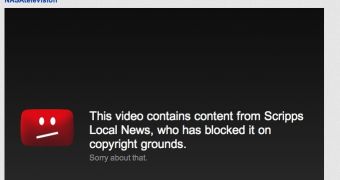It really is starting to look like people should finally be noticing the ridiculousness of the current copyright system and the extent to which it is being abused. But that's probably optimistic.
Still, having an official NASA video of the Curiosity Mars rover landing taken down for several hours by a copyright infringement accusation by some local news TV station should be proof enough that things need to change.
Curiosity has been a great development for space exploration, if only because it managed to spark the public's imagination like few other similar missions have recently.
Plenty of people wanted to find out more about it and what better source than the official NASA YouTube channel. But what they got instead was a notice from YouTube that the video they wanted to see was being blocked. The video is now back up.
The video is in the public domain since NASA is funded by the (US) public. No one owns the copyrights to it, which is why it's even more despicable that a two-bit TV station with a known history of sending false notifications is able to block it without anyone batting an eye.
What's worse is that nothing will happen to the TV station, even though, by law, those issuing these takedown notices are obligated to do them in good faith and can face perjury charges if they don't. In practice, this has never happened.
The way this happened isn't much of a mystery to anyone following the space. Many copyright holders have automated systems that take advantage of YouTube's ContentID. These systems upload videos they claim to have copyrights to and YouTube scans all uploads for snippets from those videos.
If a match is found, the infringing video can be blocked. In this case, what happened was that the station aired a portion of the video provided by NASA during one of its shows.
But YouTube had no way of knowing this and believed the initial NASA video to be infringing since NASA doesn't employ the same ContentID system to check whether its videos get reuploaded. It would make no sense to do it either since these videos, for the most part, are in the public domain.

 14 DAY TRIAL //
14 DAY TRIAL // 